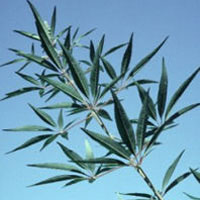Search Healthnotes
Vitex
 © Steven Foster
© Steven FosterParts Used & Where Grown
Vitex (Agnus castus) grows in Mediterranean countries and central Asia. The dried fruit, which has a pepper-like aroma and flavor, is used in herbal medicine preparations.
- Reliable and relatively consistent scientific data showing a substantial health benefit.
- Contradictory, insufficient, or preliminary studies suggesting a health benefit or minimal health benefit.
- For an herb, supported by traditional use but minimal or no scientific evidence. For a supplement, little scientific support.
Our proprietary “Star-Rating” system was developed to help you easily understand the amount of scientific support behind each supplement in relation to a specific health condition. While there is no way to predict whether a vitamin, mineral, or herb will successfully treat or prevent associated health conditions, our unique ratings tell you how well these supplements are understood by the medical community, and whether studies have found them to be effective for other people.
For over a decade, our team has combed through thousands of research articles published in reputable journals. To help you make educated decisions, and to better understand controversial or confusing supplements, our medical experts have digested the science into these three easy-to-follow ratings. We hope this provides you with a helpful resource to make informed decisions towards your health and well-being.
This supplement has been used in connection with the following health conditions:
| Used for | Amount | Why |
|---|---|---|
Premenstrual Syndrome | 20 mg a day of a concentrated herbal extract | Vitex has been shown to help balance of estrogen and progesterone during the menstrual cycle and may alleviate PMS symptoms. |
Female Infertility | 40 drops of a liquid extract with water or 35 to 40 mg of encapsulated powder each morning | Vitex has been shown to improve fertility, particularly for women with luteal phase defect, it should be discontinued once a woman becomes pregnant. |
Fibrocystic Breast Disease | 40 drops of a concentrated liquid herbal extract or 35 to 40 mg of the equivalent dried, powdered extract taken once daily in the morning with liquid | Agnus castus has been shown in some studies to reduce breast tenderness.
|
Acne Vulgaris and Premenstruation | Refer to label instructions | Some older, preliminary research suggests that vitex might help clear premenstrual acne, possibly by regulating hormonal influences. |
Amenorrhea | Refer to label instructions | In herbal medicine, vitex, also known as chaste tree, is sometimes used to treat amenorrhea. Research suggests it may regulate hormones related to menstruation and fertility. |
Breast-Feeding Support | Refer to label instructions | as Vitex Topical Vitex agnus castus is one of the best-recognized herbs in Europe for promoting lactation. It should not be used during pregnancy.
|
Dysmenorrhea | Refer to label instructions | Clinical reports from Germany have suggested that vitex may help relieve different menstrual abnormalities associated with premenstrual syndrome, including dysmenorrhea. |
Endometriosis | Refer to label instructions | Vitex is recommended either alone or in combination with other herbs, such as dandelion root, prickly ash, and motherwort, by some doctors to treat endometriosis symptoms. |
Menorrhagia | Refer to label instructions | Among women taking vitex, menorrhagia has reportedly improved after taking the herb for several months. |
Pregnancy and Postpartum Support | Refer to label instructions | Vitex is one of the best recognized herbs in Europe for promoting lactation. One trial found that vitex tincture could increase the amount of milk produced by mothers with or without pregnancy complications. |
Traditional Use (May Not Be Supported by Scientific Studies)
Hippocrates, Dioscorides, and Theophrastus mention the use of vitex for a wide variety of conditions, including hemorrhage following childbirth and assisting with the “passing of afterbirth.” Decoctions of the fruit and plant were also used in sitz baths for diseases of the uterus. In addition, vitex was believed to suppress libido and inspire chastity, which explains one of its common names, chaste tree.
Copyright © 2026 TraceGains, Inc. All rights reserved.
Learn more about TraceGains, the company.
The information presented by TraceGains is for informational purposes only. It is based on scientific studies (human, animal, or in vitro), clinical experience, or traditional usage as cited in each article. The results reported may not necessarily occur in all individuals. Self-treatment is not recommended for life-threatening conditions that require medical treatment under a doctor's care. For many of the conditions discussed, treatment with prescription or over the counter medication is also available. Consult your doctor, practitioner, and/or pharmacist for any health problem and before using any supplements or before making any changes in prescribed medications. Information expires December 2026.










